Features of growing and planting onion sets
The main secret of large heads and high yields is growing onions from sets. This method saves time - the harvest is obtained in one season. The finished planting material of different varieties is zoned according to climatic zones. We will help you understand the varietal variety, tell you about the qualities of seedlings and methods of growing.
The content of the article
Description
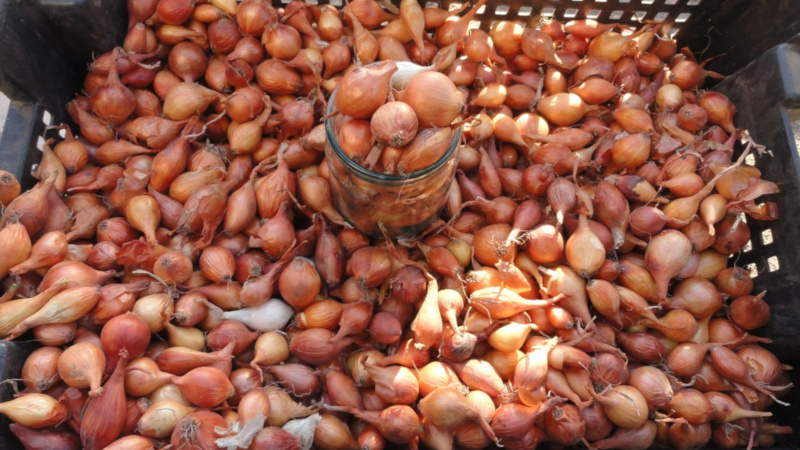
Onion sets are planting material for onions of different varieties, an intermediate stage between seeds (nigella) and a full-fledged head.
Onions have a long growing season. It takes about 6 months from sowing the seeds to the ripening of a full head. For the climate of most of the country, this method of growing is not suitable, so it is divided into two years. In the first year, small bulbs (sets) with a diameter of up to 3 cm are harvested from seeds. In the second year, sets produce large varietal bulbs.
Varieties of varieties
In Russia, vegetable growers are offered more than 60 varieties of sevka. When choosing, they take into account the zoning, taste characteristics and purpose, ripening periods, yield and resistance of the crop to diseases.
By origin and growing conditions, varieties are divided into:
- southern - heat-loving onions of short daylight hours, at low temperatures they lose their taste and mass;
- northern - frost-resistant plants of long daylight hours.
To taste and purpose:
- sweet - the bulbs are juicy, suitable for freezing, consumed fresh, but not stored;
- sharp - early ripening onions, less productive, dense, with several layers of scales, stored until spring without losing their presentation;
- semi-sharp - heads with a mild taste and multilayer scales, used for processing, storage (about 6 months) and fresh consumption.
Ripening varieties:
- early ripening - the harvest is harvested in 85-100 days;
- mid-ripening - with a growing season of about 125 days;
- late - over 125 days.
The chemical composition and useful properties of onions
Mass fraction of vitamins per 100 g:
- C - 10 mg;
- E - 0.2 mg;
- H - 0.9 μg;
- K - 0.4 μg;
- PP - 0.5 mg;
- B1 - 0.05 mg;
- B2 - 0.02 mg;
- B4 - 6.1 mg;
- B5 - 0.1 mg;
- B6 - 0.12 mg;
- B9 - 9 mcg;
- beta-carotene - 0.001 mg;
- niacin - 0.2 mg.
Macro- and microelements per 100 g:
- potassium - 175 mg;
- sulfur - 65 mg;
- phosphorus - 58 mg;
- calcium - 31 mg;
- chlorine - 25 mg;
- magnesium - 14 mg;
- silicon - 5 mg;
- sodium - 4 mg;
- rubidium - 476 mcg;
- aluminum - 400 mcg;
- boron - 200 mcg;
- copper - 85 mcg;
- fluorine - 31 mcg;
- zinc - 0.85 mg;
- chromium - 2 μg;
- iodine - 3 mcg;
- manganese - 0.23 mg;
- selenium - 0.5 mcg;
- iron - 0.8 mg;
- nickel - 3 mcg;
- cobalt - 5 mcg.
Nutritional value of 100 g fresh onions - 41 kcal, containing:
- proteins - 1.4 g;
- fat - 0.2 g;
- carbohydrates - 8.2 g;
- water - 86 g;
- fiber - 3 g;
- organic acids - 0.2 g
With any processing, the biochemical composition of the vegetable is preserved. Onions stimulate the secretion of gastric juice, therefore it is recommended for a dietary menu.
Efficiency spectrum:
- possesses bactericidal properties;
- effective antioxidant;
- prevents vitamin deficiency and anemia;
- strengthens the immune system;
- stabilizes the nervous system;
- promotes hair growth and strengthening;
- improves skin color;
- the first remedy for the prevention of viral diseases;
- helps with frostbite and burns;
- has a diuretic and anthelmintic effect.
Characteristics of sevka bulbs
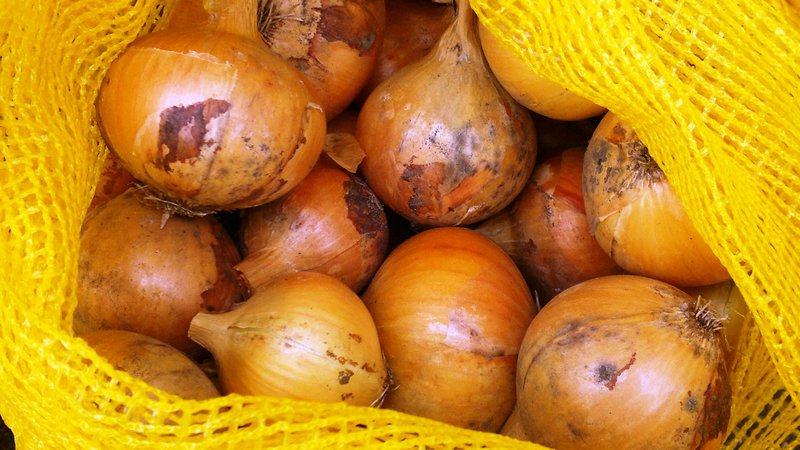
The shape and color of the heads depend on the variety. Good quality bulbs are smooth, firm, evenly colored and well dried. They are classified by size:
- Small (8-14 mm in diameter) - no arrows. To get a full harvest, they are planted before winter. When planting in spring, the bulbs do not gain weight.
- Medium (14-21 mm) - no shooters. Suitable for spring and winter planting.
- Large (21-24 mm) - planted in spring and before winter, shoots quickly.
- Large seeding (24-30 mm) - recommended for early spring greens.
Single-fraction planting material provides an increase in yield by 20%, one-time germination and maturation, one-dimensional heads.
The best varieties of onion sets for different regions
Sevok for the Urals and Siberia:
- Sturon. A mid-season, cold-resistant Dutch onion variety with a ripening period of 100-115 days. Semi-sharp to taste. The heads are transversely elliptical, with dense brownish scales, weighing 100-200 g. Resistant to major diseases and pests. Stored up to 6 months.
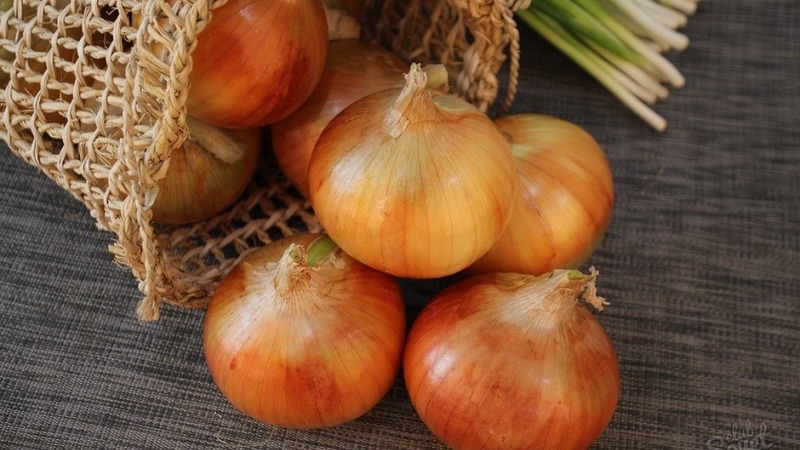
- Siberian annual. Early ripening variety with heads up to 200 g. Bulbs are multi-edged, round-flat, juicy, with yellow outer scales. The taste is semi-sharp. Differs in resistance to shooting and stable yield (3 kg / m²). Keeping quality up to 8 months.
- Stuttgarter rizen. Early ripe onions with a spicy taste. The heads are rounded, flattened above and below, with dense, smooth scales of golden brown color. Medium juicy pulp. Ripening period - up to 80 days. Average weight of bulbs - 180 g. Adapted to any weather conditions, resistant to downy mildew. Stored until spring.
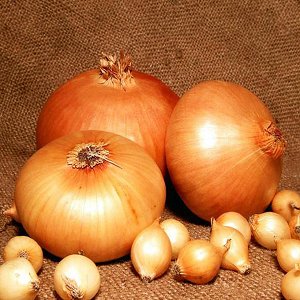
For the middle lane and the Moscow region:
- Hercules F1... Large-fruited, high-yielding hybrid with a ripening period of 70-80 days. The heads are dense, golden yellow, weighing up to 300 g, spicy to taste, without bitterness. Resistant to crop diseases, rarely affected by pests. Productivity - up to 8 kg / m². It can be stored for about 6 months without loss of taste and presentation.
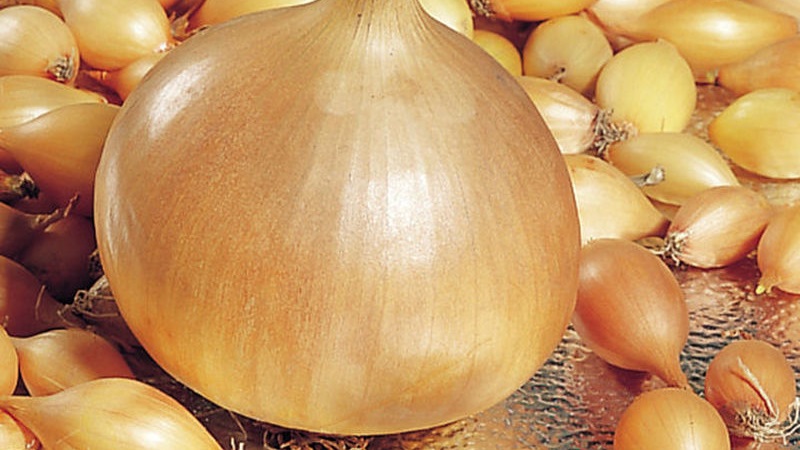 Bow Hercules
Bow Hercules - Centurion. Early maturing, cold-resistant variety, resistant to shooting, fungal diseases and spring frosts down to -4 ° C. The heads are slightly elongated, elastic, golden brown, weighing up to 100 g. Productivity - 8 kg / m², stored for 5-6 months.
Southern varieties:
- Krasnodar G-35... Bulbs are two-bud, oval, weighing 90-114 g. The color of dry scales is yellow-pink. The ripening period is 95-140 days. The pulp is juicy, sweetish in taste. The crop is not for long-term storage. Up to 4 kg are harvested from 1 m².
- Spanish 313... Late ripening, ripens in 140 days. The heads are large - up to 300 g, rounded, pale yellow in color with a pinkish tinge. It tastes sweet, with a slight pungency. The crop is not stored for a long time, about 5 kg / m² are harvested.
Benefits of growing onions from sets
Growing onions from seed sets allows you to get a full harvest in one season. For the northern regions of Russia, this is the only way in which the culture has time to mature.
Pros of using sevka:
- shortening the growing season;
- rapid development and strengthening of the root system;
- increased resistance to shooting;
- the heads are gaining maximum weight;
- less susceptibility to weeds.
Features of planting and growing
Planting material is purchased ready-made or grown from seeds.
Growing seedlings from nigella
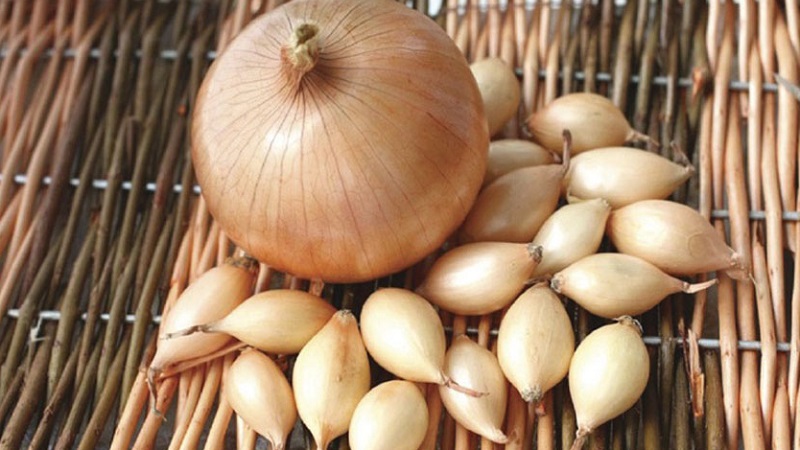
Nigella is sown in early spring at a temperature of + 2 ... + 4 ° C or before winter with a steady drop in temperature to 0 ° C.
Work order:
- The plot is dug up and leveled a month before winter sowing. A bucket of loose soil is left in a warm place.
- They are sown in frozen ground and covered with a layer of prepared soil up to 3 cm.
- In spring sowing, the place is prepared in the fall. Pre-moisten the soil.
- Seeds are sorted - small and empty are removed.
- Sow with ribbons on beds up to 1 m wide in 6-12-row grooves with a distance of 8 cm or on a flat surface - 10 g of seeds per 1 m². Fall asleep with moist earth in a layer up to 2 cm.
- Seedlings are not thinned out so that the seedlings do not outgrow.
- Watered 1-2 times a week at 5-10 l / m².
- During germination, they are fed with a solution of slurry or urea (1 tablespoon per 10 liters of water).
- In the phase of head formation (3-4 adult feathers appear), watering and feeding are stopped.
- Sevok is harvested at the beginning of feather lodging. Wither in the sun until the stems and scales on the heads are completely dry.
Seeding preparation for planting
Onions are planted in flat, sunny areas or in stationary beds. In autumn, the earth is dug to the depth of a bayonet and humus is introduced (5-6 kg / m²), and in the spring it is loosened.
Soil and predecessor crops
Chernozem, loamy and sandy loam soils with neutral or slightly alkaline acidity (6.4-7.9 pH) are suitable. Onions grow and develop rapidly in light, loose soil that absorbs moisture well. On loam, the taste of the heads improves.
The vegetable is not planted after peas, beans, broccoli, turnips, sage, parsnips, parsley and dill.
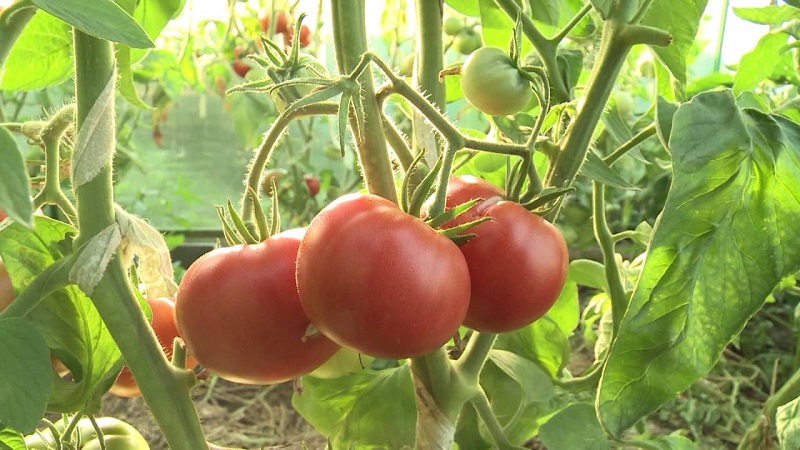
Favorable predecessors:
- tomatoes;
- cucumbers;
- potatoes;
- beet;
- zucchini;
- pumpkin;
- eggplant;
- spinach.
It is better to choose carrots, peppers, tomatoes, strawberries, beets as neighbors. Undesirable neighborhood - legumes.
Timing, scheme and landing rules
In spring, seedlings are planted when the topsoil warms up to + 4 ... + 5 ° C or at an established air temperature of + 10 ° C. In autumn - 15 days before the first frost, so that it has time to take root, but does not sprout.
Work order:
- Planting material is sorted by size, dry necks are cut, damaged and germinating bulbs are removed.
- For 2 hours, the heads are soaked in a warm saline solution (1 tbsp. L. Per 1 l of water). Salt disinfects from nematodes and accelerates growth. Sevok is rinsed after salt and disinfected for 30 minutes in a solution of potassium permanganate (3 g of powder per 3 l of water), which prevents the development of fungal diseases.
- The bed is leveled and grooves are formed 5 cm deep at a distance of about 40 cm.
- The grooves are powdered with wood ash and spilled with hot water so that the earth warms up and settles.
- Small heads (up to 1 cm) are laid at a distance of 5-7 cm, medium and large (1.5-2.5 cm) - in increments of 8-10 cm, sprinkled with earth and watered.
Growing features
In the northern regions, onions are planted from east to west. In the southern regions, the beds are located from north to south. This technique provides uniform illumination, the soil warms up equally along the entire length of the beds, the bulbs ripen at the same time.
The main concern is proper feeding and timely watering. Fertilizers are applied to wet soil, weeding is replaced by mulching.
Watering mode
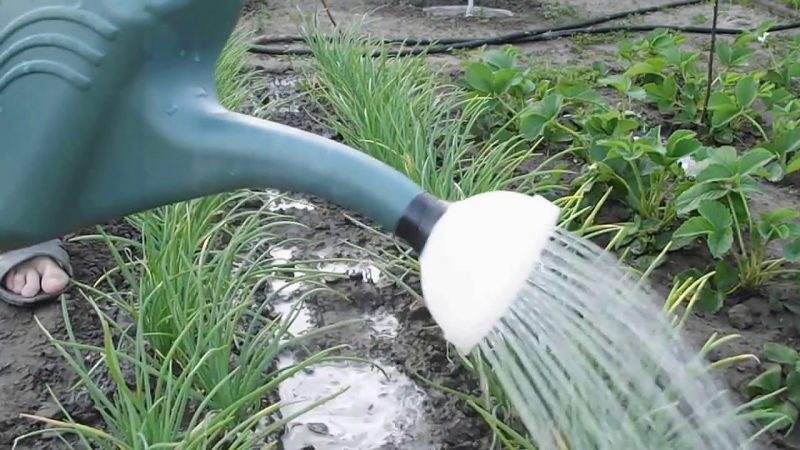
Water from the moment of germination. The first 2 weeks maintain constant soil moisture. Further - 1 time in 7-10 days at 7-8 l / m². In the heat - up to 2 times a week. A month before harvesting, watering is replaced by loosening.
Attention! Waterlogging provokes fungal diseases. With insufficient watering, the bulbs stop gaining mass and will taste too bitter.
After each watering, the soil is loosened and weeds are removed.
Top dressing
The vegetable is fed 3 times per season:
- during germination (after 5-6 days from the moment landing) give 1 liter of slurry per 10 liters of water or 200 g of chicken manure per 10 liters of water;
- after 2 weeks from the first, fertilize with herbal infusion or mineral complex (superphosphate 30 g, urea 10 g and potassium 5 g per bucket of water);
- after increasing the diameter of the heads to 4 cm, they are fed with herbal infusion with the addition of potassium or a mineral solution (superphosphate 60 g and potassium chloride 30 g per bucket of water).
Disease and pest control
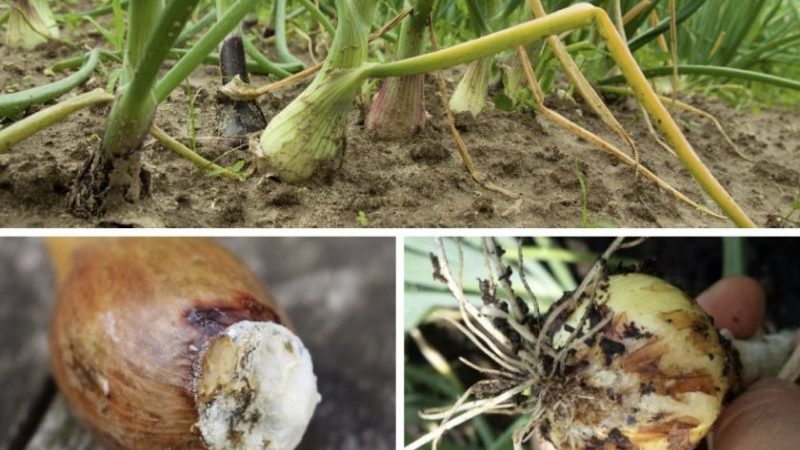
Due to the property of bulbs to accumulate toxic substances, the culture is not treated with chemicals.
The main focus in plant protection is prevention:
- Fusarium - the feather turns yellow, the bottom of the bulbs rots. The causes of the disease are fungal spores and onion fly.Before planting, the seedlings are warmed up to 40-45 ° C, soaked in a solution of potassium permanganate.
- Downy mildew is a gray coating on the stem and leaves. The reason is the thickening of the plantings. They are thinned out, the sets are warmed up before planting.
- Against the caterpillars of the scoop, onions are treated with a 0.5% solution of "Gomelin".
- To prevent onion fly attacks, the beds are dusted with wood ash or salted during planting. Carrots are planted next to the onions.
- Onion moth - the beds are cleaned of weeds. In case of severe damage, it is treated with Fitoverma solution.
Difficulties
When growing onions on a head, it is important to avoid arrowing - when arrows-inflorescences appear on the tips of the feathers. This reduces the yield. The heads do not receive enough power, grow smaller and are poorly stored.
Reasons for shooting:
- poor quality planting material;
- violation of storage conditions for sevka;
- incorrect calibration for winter and spring planting;
- the timing of planting works has been shifted.
To save the crop, the arrows are removed under the neck.
Harvesting and storage
In ripe onions, the stems turn yellow and lie down, the necks become thinner and dry out. The crop is harvested 5-10 days before the mass lodging of the feather.
The heads are dug out with a pitchfork or pulled out. Dried in the sun or under a canopy until the stems are completely dry. The bulbs are sorted, cleaned off the soil and excess husk, the roots and stems are cut off, only dense, healthy heads are left for storage.
Store in wooden boxes, in a dark room with good ventilation at a temperature of 0 ... + 3 ° C and humidity up to 85%.
Planting seedlings are stored in a basement and room conditions - in a dark place at a temperature of + 17 ... + 24 ° C and humidity up to 70%.
Tips from experienced gardeners
Many gardeners recommend planting onions and other crops in long, two-row, wide-aisle beds. This is a new vegetable growing technology for small areas.
With this method of cultivation, all plants receive a sufficient amount of nutrients from the soil and air. Vegetables do not get sick, are slightly affected by pests, the bulbs grow larger, and the care process is less laborious.
Reviews of the varieties of onion sets
Some growers like to experiment. Others prefer to plant familiar, proven varieties.
Sergey, Krasnoyarsk: "I bought sevok and did not know that there are many different varieties. Now I'm planting Sturon. The bulbs grow much larger than indicated on the package - each from 200 to 300 g. I am satisfied with the variety. "
Elena Fedorovna, Kolomna: “My neighbor's son brought a set of hybrid Hercules F1. The harvest exceeded all expectations. The bulbs are simply huge, one-dimensional and taste without bitterness, spicy. I will definitely plant the same one. "
Victoria, Mozhaisk: “Sevkom planting Centurion and Strigunovsky. The varieties are reliable, the onion does not get sick. We don't worry about the weather either, the harvests are always stable. "
Conclusion
Growing onions from seed sets shortens the development time of a crop from germination to a full harvest. With this method, plants quickly take root, increasing resistance to diseases and environmental conditions. Vegetable growers plant different varieties of seedlings throughout Russia and note that this planting material produces the largest bulbs.